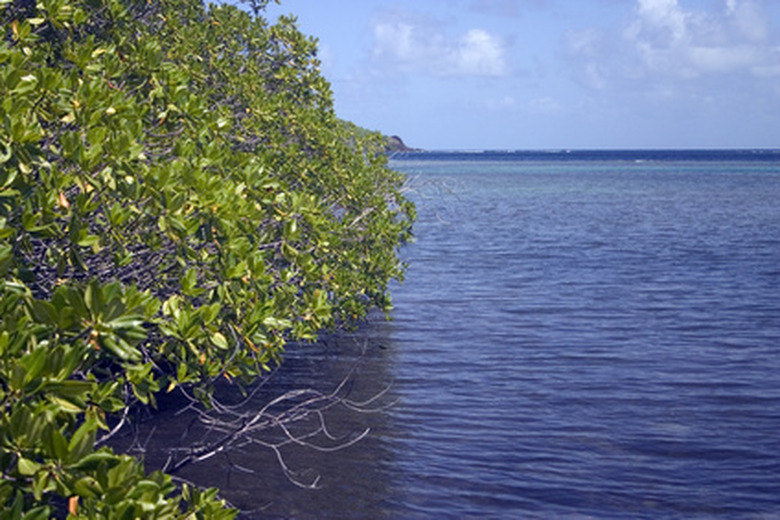The Effect Of Salinity On Photosynthesis
Photosynthesis is a vital process that produces oxygen for plants and animals. More important to the plant, the process produces energy for growth and reproduction. Saline, or salt-dense environments such as ocean coasts, threaten the ability of plants to undergo photosynthesis. Some plant species have adapted to these conditions, producing energy in spite of difficult circumstances.
Osmosis
Osmosis
A key factor in a plant's survival is its osmotic potential. Osmosis is the process of transferring water from a place of low salinity to a place of high salinity. The osmotic potential of a plant describes the attraction of water to the plant's cells. Therefore, a plant whose salinity is higher than that of its surroundings has a high osmotic potential because it is likely to attract water into its cells, bringing balance to the salinity inside and outside the plant. The opposite condition is one of low salinity.
Water Retention
Water Retention
A plant in a saline environment is in a difficult position for water retention. The high osmotic potential of the environment under these conditions favors the movement of water from the plant to the outside environment. To prevent water loss through transpiration, the plant's stomata will remain closed. Although this will help the plant keep precious water resources and maintain a healthy balance of nutrients and water, the closing of the stomata also prevents uptake of carbon dioxide, preventing the plant from assimilating energy through photosynthesis.
Nutrient Loss
Nutrient Loss
With the stomata closed and transpiration stopped to prevent water loss, the plant will retain most of its water successfully. Transpiration, however, also has an important role in moving nutrients and water throughout the plant. According to the tension-cohesion theory, water loss through transpiration at the top of the plant creates an osmotic potential that generates movement of water upward from the plant's roots. The water transports important nutrients acquired from the soil through the xylem and into the leaves.
Adaptations
Adaptations
Some plant species have adapted to saline conditions in ways similar to plants that live in dry, desert conditions. These plants increase their amino acid supply, lowering the osmotic potential in their roots. This change in potential allows water to be transferred up the xylem as it is during transpiration. Water then reaches the plant's leaves. Another adaptation that prevents water loss to the saline environment is the evolution of specialized leaves that contain a waxy, less permeable, coating.
Halophytes
Halophytes
About 2 percent of plant species have adapted permanently to saline conditions. These species are called halophytes. They exist in saline environments where they are either rooted in salt dense water or are sprayed and flooded periodically by ocean water. They may be found in semi-deserts, mangrove swamps, marshes or along seashores. These species take sodium and chloride ions from the surrounding environment and transport them to the leaf cells, redirecting them from the sensitive cell parts and storing them in the cell's vacuoles (storage bin-like organelles). This uptake raises the plant's osmotic potential in a saline environment, allowing water to enter the plant. Some halophytes have salt glands in their leaves, and transport the salt directly out of the plant. This characteristic is seen in some mangroves that grow in saltwater.
Cite This Article
MLA
Jansen, Jim. "The Effect Of Salinity On Photosynthesis" sciencing.com, https://www.sciencing.com/effect-salinity-photosynthesis-6398405/. 22 November 2019.
APA
Jansen, Jim. (2019, November 22). The Effect Of Salinity On Photosynthesis. sciencing.com. Retrieved from https://www.sciencing.com/effect-salinity-photosynthesis-6398405/
Chicago
Jansen, Jim. The Effect Of Salinity On Photosynthesis last modified March 24, 2022. https://www.sciencing.com/effect-salinity-photosynthesis-6398405/
